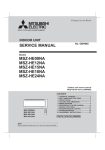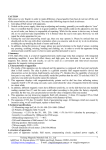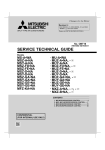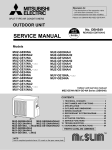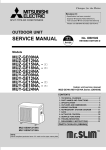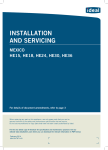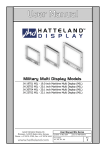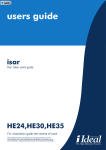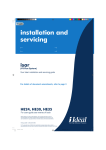Download SERVICE TECHNICAL GUIDE
Transcript
SPLIT-TYPE AIR CONDITIONERS No. OBT49 SERVICE TECHNICAL GUIDE Models MSZ-HE09NA MSZ-HE12NA MSZ-HE15NA MSZ-HE18NA MSZ-HE24NA MUZ-HE09NA MUZ-HE12NA MUZ-HE15NA MUZ-HE18NA MUZ-HE24NA CONTENTS 1. MSZ MICROPROCESSOR CONTROL················ 3 CONFIDENTIAL (FOR INTERNAL USE ONLY) 1. MSZ MICROPROCESSOR CONTROL ················································································································· 3 Indoor unit models Outdoor unit models MSZ-HE09NA MSZ-HE12NA MSZ-HE15NA MSZ-HE18NA MSZ-HE24NA MUZ-HE09NA MUZ-HE12NA MUZ-HE15NA MUZ-HE18NA MUZ-HE24NA 1-1. COOL OPERATION ······································································································································· 3 1-2. DRY OPERATION ·········································································································································· 4 1-3. HEAT OPERATION ········································································································································ 4 1-4. AUTO CHANGE OVER ··· AUTO MODE OPERATION················································································· 7 1-5. OUTDOOR FAN MOTOR CONTROL ············································································································ 7 1-6. AUTO VANE OPERATION ····························································································································· 7 1-7. INVERTER SYSTEM CONTROL ··················································································································· 8 1-8. OPERATIONAL FREQUENCY CONTROL OF OUTDOOR UNIT ······························································ 12 1-9. EXPANSION VALVE CONTROL (LEV CONTROL) ···················································································· 13 1-10. PRE-HEAT CONTROL ································································································································· 15 OBT49 2 2 MSZ MICROPROCESSOR CONTROL 1-1. COOL ( ) OPERATION 1. Thermostat control Thermostat turns ON or OFF by the difference between room temperature and set temperature. Thermostat ON OFF Room temperature minus set temperature (Initial) Room temperature minus set temperature (During operation) -1.35°F (-0.75°C) or more less than -1.8°F (-1°C) -2.25°F -1.35°F (-1.25°C) (-0.75°C) 2. Indoor fan speed control Indoor fan operates continuously at the set speed by FAN SPEED CONTROL button regardless of the thermostat's OFFON. In AUTO the fan speed is as follows. Fan speed High Med. Low Room temperature minus set temperature (Initial) 3.15°F(1.75°C) or more between 1.8 and 3.15°F less than 1.8°F(1°C) Room temperature minus set temperature (During operation) 1.8°F (1°C) 3.15°F (1.75°C) 5.4°F (3°C) 3. Coil frost prevention The compressor operational frequency is controlled to prevent the temperature of indoor heat exchanger from falling excessively. The compressor is turned OFF for 5 minutes when the temperature of indoor coil thermistor continues 37°F (3°C) or less for 5 minutes or more. The indoor fan maintains the actual speed of the moment. 4. Low outside temperature operation If the outside temperature falls to 64°F (18°C) or less during operation in COOL mode, the unit will switch to the low outside temperature operation mode. <Operation> (1) Outdoor fan control The outdoor fan rotational speed slows down to maintain sufficient cooling capacity. NOTE: Even when the unit is in the "thermostat-off" status under the low outside temperature operation mode, the outdoor fan rotation does not stop. (2) Dew drop prevention When the ambient temperature thermistor reads 14°F (-10°C) or less (the set temperature is different depending on the models), as coil frost or dew drop from indoor unit may occur, the compressor turns OFF with the outdoor fan OFF for prevention of them. (3) Outdoor temperature detecting control To detect the exact outdoor temperature in this mode, the compressor turns OFF but the outdoor fan stays ON for 3 minutes once 1 hour. If the outdoor temperature rises over about 64°F (18°C), the unit goes back to the normal COOL mode. If the outside temperature stays below about 64°F (18°C), the unit continues to run in the low outside temperature operation mode. Other protections work as well as in the normal COOL mode. OBT49 3 ) OPERATION Set temperature is as shown on the right chart. The system for dry operation uses the same refrigerant circuit as the cooling circuit. The compressor and the indoor fan are controlled by the room temperature. By such controls, indoor flow amounts will be reduced in order to lower humidity without much room temperature decrease. 1. Thermostat control Thermostat turns ON or OFF by the difference between room temperature and set temperature. Thermostat ON OFF 95(35) Set temperature [°F(°C)] 1-2. DRY ( Set temperature and initial room temperature in dry mode 86(30) 77(25) 68(20) 59(15) 50(10) 50 (10) Room temperature minus set temperature (Initial) 59 68 77 86 95 (15) (20) (25) (30) (35) Initial room temperature [°F(°C)] Room temperature minus set temperature (During operation) -3.15°F (-1.75°C) or more less than -3.6°F (-2°C) 2. Indoor fan speed control Indoor fan operates at the set speed by FAN SPEED CONTROL button. When the thermostat turns OFF (compressor OFF), fan speed becomes Very Low. In AUTO the fan speed is as follows. Room temperature minus Fan speed set temperature (Initial) High 3.15°F(1.75°C) or more Med. between 1.8 and 3.15°F Low less than 1.8°F(1°C) -4.05°F -3.15°F (-2.25°C) (-1.75°C) Room temperature minus set temperature (During operation) 1.8°F (1°C) 4.5°F (2.5°C) 3.15°F (1.75°C) 3. Coil frost prevention Coil frost prevention works the same way as that in COOL mode. (1-1.3.) The indoor fan maintains the actual speed of the moment. However, when coil frost prevention works while the compressor is not operating, its speed becomes the set speed. 4. Low outside temperature operation Low outside temperature operation works the same way as that in COOL mode. (1-1.4.) 1-3. HEAT ( ) OPERATION 1. Thermostat control Thermostat turns ON or OFF by difference between room temperature and set temperature. Thermostat ON OFF Room temperature minus set temperature (Initial) less than 1.8°F(1°C) 1.8°F(1°C) or more 2. Indoor fan speed control (1) Indoor fan operates at the set speed by FAN SPEED CONTROL button. In Auto the fan speed is as follows. Set temperature minus Fan speed room temperature (Initial) High Med. Low OBT49 3.6°F(2°C) or more Between 0.45 and 3.6°F Less than 0.45°F(0.25°C) 4 Room temperature minus set temperature (During operation) 1.35°F 1.8°F (0.75°C) (1°C) Set temperature minus room temperature (During operation) 3.6°F (2°C) 0.45°F 3.15°F (0.25°C) (1.75°C) 7.2°F (4°C) (2) Cold air prevention control When the compressor is not operating, ( ) if the temperature of room temperature thermistor is less than 66°F (19°C), the fan stops. ( ) if the temperature of room temperature thermistor is 66°F (19°C) or more and ( ) if the temperature of indoor coil thermistor is less than 32°F (0°C), the fan stops. ( ) if the temperature of indoor coil thermistor is 32°F (0°C) or more, the fan operates at Very Low. When the compressor is operating, ( ) if the temperature of indoor coil thermistor is 104°F (40°C) or more, the fan operates at set speed. ( ) if the temperature of indoor coil thermistor is less than 104°F (40°C) and ( ) if heating operation starts after defrosting, the fan stops. ( ) if the temperature of room temperature thermistor is 66°F (19°C) or less, the fan stops. ( ) if the temperature of room temperature thermistor is more than 66°F (19°C), the fan operates at Very Low. NOTE: When 3 minutes (MSZ-HE09/12/18NA)/ 4 minutes (MSZ-HE24NA) have passed since the compressor started operation, this control is released regardless of the temperature of room temperature thermistor and indoor coil thermistor. (3) Warm air control When the following any condition of (a. ~ c.) and the condition of are satisfied at the same time, warm air control works. a.) Fan speed is used in MANUAL. b.) When cold air prevention has been released. c.) When defrosting has been finished. When the temperature of indoor coil thermistor is less than 104°F (40°C). When warm air control works, the fan speed changes as follows to blow out warm air gradually. Gradation of fan speed in initial MSZ-HE09/12/15/18NA <Time condition> <Indoor fan speed> Less than 2 minutes------------ Low 2 to 4 minutes-------------------- Med. More than 4 minutes ----------- High MSZ-HE24NA <Time condition> <Indoor fan speed> Less than 4 minutes------------ Low 4 to 8 minutes-------------------- Med. More than 8 minutes ----------- High The upper limit of the fan speed in MANUAL is the set speed. When the temperature of indoor coil thermistor has been 104°F (40°C) or more, or when the set speed has been changed, this control is released and the fan speed is the set speed. 3. Overload starting When the room temperature thermistor reads 64°F (18°C) or more, the compressor runs with its maximum frequency regulated for 10 minutes after the start-up. 4. Defrosting (1) Starting conditions of defrosting When the following conditions a) ~ c) are satisfied, the defrosting starts. a) The defrost thermistor reads about 30.2°F (-1°C) or less. b) The cumulative operation time of the compressor has reached any of the set values (defrost interval: 40-150 minutes). c) More than 5 minutes have passed since the start-up of the compressor. The defrost interval is decided by the previous defrosting time. The next defrost interval extends or shortens 0-20 minutes compared with the previous defrost interval. (2) Releasing conditions of defrosting Defrosting is released when any one of the following conditions is satisfied: a) The defrost thermistor continues to read "Defrost finish temperature" for 30 seconds. Refer to "CHANGE IN DEFROST SETTING of SERVICE FUNCTIONS in OUTDOOR UNIT SERVICE MANUAL". b) Defrosting time has exceeded 10 minutes. c) Any other mode than HEAT mode is set during defrosting. OBT49 5 Time chart of defrosting in HEAT mode (reverse type) <Indoor unit> Horizontal vane horizontal set position Indoor fan horizontal (temperature of indoor coil thermistor < 102 °F) (39°C) set speed Very Low (temperature of indoor coil thermistor > 64 °F) (18°C) OFF set position set speed 30 seconds <Outdoor unit> Maximum frequency Compressor normal OFF 40 30 seconds seconds OFF 40 seconds 5 seconds ON 30 seconds 5 seconds ON Outdoor fan OFF R.V. coil (21S4) OBT49 ON (HEAT) ON (HEAT) OFF (COOL) 6 1-4. AUTO CHANGE OVER ··· AUTO MODE OPERATION Once desired temperature is set, unit operation is switched automatically between COOL and HEAT operation. 1. Mode selection (1) Initial mode At first indoor unit operates only indoor fan with outdoor unit OFF for 3 minutes to detect present room temperature. Following the conditions below, operation mode is selected. If the room temperature thermistor reads more than set temperature, COOL mode is selected. If the room temperature thermistor reads set temperature or less, HEAT mode is selected. (2) Mode change In case of the following conditions, the operation mode is changed. COOL mode changes to HEAT mode when 15 minutes have passed with the room temperature 2 - 4°F (1 - 2°C) below the set temperature. HEAT mode changes to COOL mode when 15 minutes have passed with the room temperature 2 - 4°F (1 - 2°C) above the set temperature. In the other cases than the above conditions, the present operation mode is continued. NOTE1: Mode selection is performed when multi standby (refer to NOTE2) is released and the unit starts operation with ON-timer. NOTE2: When two or more indoor units are operating simultaneously, the indoor unit, which is operating in AUTO ( ), might not be able to change over the operating mode (COOL ↔ HEAT) and becomes the standby state. (3) Indoor fan control/ Vane control As the indoor fan speed and the horizontal vane position depend on the selected operation mode, when the operation mode changes over, they change to the exclusive ones. 1-5. OUTDOOR FAN MOTOR CONTROL Fan speed is switched according to the compressor frequency. Fan speed <Relation between compressor frequency and fan speed> Down Up Compressor frequency (Hz) High Applied model Down Up MUZ-HE09 39 54 Low MUZ-HE12/15/18 33 44 Min. Compressor frequency Max. MUZ-HE24 33 43 1-6. AUTO VANE OPERATION 1. Horizontal vane (1) Cold air prevention in HEAT operation When any of the following conditions occur in HEAT operation, the vane angle changes to Horizontal position automatically to prevent cold air blowing on users. Compressor is not operating. Defrosting is performed. Indoor coil thermistor temperature does not exceed 102°F (39°C) within about 3 minutes after compressor starts. NOTE: When 2 or more indoor units are operated with multi outdoor unit, even if any indoor unit turns thermostat OFF, this control does not work in the indoor unit. (2) ECONO COOL ( ) operation (ECONOmical operation) When ECONO COOL button is pressed in COOL mode, set temperature is automatically set 3.6°F (2°C) higher than that in COOL mode. Also the horizontal vane swings in various cycle according to the temperature of indoor heat exchanger (indoor coil thermistor). SWING operation makes you feel cooler than set temperature. So, even though the set temperature is higher than that in COOL mode, the air conditioner can keep comfort. As a result, energy can be saved. To cancel this operation, select a different mode or press one of the following buttons in ECONO COOL operation: ECONO COOL or VANE CONTROL button. OBT49 7 <SWING operation> In swing operation of ECONO COOL operation mode, the initial air flow direction is adjusted to “Horizontal”. According to the temperature of indoor coil thermistor RT12 at starting of this operation, next downward blow time is decided. Then when the downward blow has been finished, next horizontal blow time is decided. For initial 10 minutes the swing operation is performed in table G~H for quick cooling. Also, after 10 minutes when the difference of set temperature and room temperature is more than 3.6°F (2°C), the swing operation is performed in table D~H for more cooling. The air conditioner repeats the swing operation in various cycle as follows. Temperature of indoor coil thermistor (°F/°C) 59/15 or less 59/15 to 63/17 63/17 to 64/18 64/18 to 68/20 68/20 to 70/21 70/21 to 72/22 72/22 to 75/24 more than 75/24 A B C D E F G H Downward blow time Horizontal blow time (second) (second) 2 23 5 20 8 17 11 14 14 11 17 8 20 5 23 2 1-7. INVERTER SYSTEM CONTROL 1-7-1. Inverter main power supply circuit MUZ-HE09/12/15/18 REACTOR POWER SUPPLY NOISE FILTER CIRCUIT RESISTOR DIODE MODULE1 + ~ ~ - + SMOOTHING CAPACITOR P V N RELAY CURRENT TRANSFORMER U U W INVERTER MODULE ~ + ~ DIODE MODULE2 V MS 3~ W COMPRESSOR SWITCHING POWER TRANSISTOR BOOSTER CHOPPER CIRCUIT Function of main parts NAME FUNCTION INVERTER MODULE It supplies 3-phase AC power to compressor. SMOOTHING CAPACITOR It stabilizes the DC voltage and supplies it to INVERTER MODULE. CURRENT TRANSFORMER It measures the current of the compressor motor. DIODE MODULE 1 It converts the AC voltage to DC voltage. RESISTOR It absorbs the rush current not to run into the main power supply circuit when the power is turned ON. RELAY It keeps the RESISTOR, which restricts rush current, short-circuited while the compressor is operating. BOOSTER CHOPPER CIRCUIT DIODE MODULE 2 SWITCHING POWER TRANSISTOR It improves power factor. It controls the bus-bar voltage. REACTOR OBT49 8 MUZ-HE24 CURRENT TRANSFORMER U U REACTOR NOISE FILTER CIRCUIT POWER SUPPLY RESISTOR + SMOOTHING CAPACITOR P V N RELAY POWER FACTOR CORRECTION MODULE W INVERTER MODULE V MS 3~ W COMPRESSOR Function of main parts NAME FUNCTION INVERTER MODULE It supplies 3-phase AC power to compressor. SMOOTHING CAPACITOR It stabilizes the DC voltage and supplies it to INVERTER MODULE. CURRENT TRANSFORMER It measures the current of the compressor motor. REACTOR It rectifies AC, controls its voltage and improves the power factor of power supply. POWER FACTOR CORRECTION MODULE RESISTOR RELAY It absorbs the rush current not to run into the main power supply circuit when the power is turned ON. It keeps the RESISTOR, which restricts rush current, short-circuited while the compressor is operating. 1-7-2. Outline of main power supply circuit MUZ-HE09/12/15/18 1. At the start of operation Main power supply circuit is formed when RELAY is turned ON at COMPRESSOR startup. To prevent rush current from running into the circuit when power supply is turned ON, RESISTOR is placed in sub circuit. 2. At normal operation When AC runs into POWER P.C. board, its external noise is eliminated in NOISE FILTER CIRCUIT. After noise is eliminated from AC, it is rectified to DC by DIODE MODULE 1. DC voltage, to which AC has been rectified by process , is stabilized by SMOOTHING CAPACITOR and supplied to INVERTER MODULE. DC voltage, which has been stabilized in process , is converted to 3-phase AC by INVERTER MODULE and supplied to COMPRESSOR. CURRENT TRANSFORMER, which is placed in the power supply circuit to COMPRESSOR, is used to measure the value of phase current and locate the polar direction of rotor with algorithm. PWM (Pulse width modulation) controls impressed voltage and frequency with those pieces of information. 3. Purpose of PAM adoption PAM (Pulse Amplitude Modulation) has been adopted for the efficiency improvement and the adaptation to IEC harmonic current emission standard Outline of simple partial switching method In conventional inverter models, DIODE MODULE rectifies AC voltage to DC voltage, SMOOTHING CAPACITOR makes its DC waveform smooth, and INVERTER MODULE converts its DC voltage to imitated AC voltage again in order to drive the compressor motor. However, it has been difficult to meet IEC harmonic current emission standard by above circuit because harmonic gets generated in the input current waveform and power factor gets down. The simple partial switching method with PAM, which has been adopted this time, places and utilizes BOOSTER CHOPPER CIRCUIT before rectifying AC voltage in the general passive-method converter circuit. As harmonic gets suppressed and the peak of waveform gets lower by adding BOOSTER CHOPPER CIRCUIT as mentioned above and by synchronizing the timing of switching with the zero-cross point of waveform, the input current waveform can be improved and the requirement of IEC harmonic current emission standard can be satisfied. Since the switching synchronized with the zero cross point, this simple partial switching method has the feature of lower energy loss compared to active filter method. In addition, output and efficiency is enhanced by combining with vector-controlled inverter in order to boost the voltage of power supplied to INVERTER MODULE. OBT49 9 Input current waveform without PAM Input current waveform with PAM Due to the time of no electricity; • Power factor gets worse. • Harmonic gets increased. Input voltage Input current Owing to the increase of energized time; • Power factor gets better. • Harmonic gets suppressed. Release of energy stored in L. Peak gets down. Energized time is extended by optimization of L inductance. Energized time is short in case L inductance is small. No electricity runs into diode module because the voltage at both sides of smoothing capacitor is higher than input voltage. Compulsory energizing by switching. 4. Inverter module INVERTER MODULE consists of the following components · IGBT (x6): Converts DC waveform to 3-phase AC waveform and outputs it. · Drive Circuit: Drives transistors. · Protection circuit: Protects transistors from overcurrent. Since the above components are all integrated in INVERTER MODULE, INVERTER MODULE has a merit to make the control circuit simplify and miniaturize. 5. Elimination of electrical noise NOISE FILTER CIRCUIT, which is formed by *CMC COILS and capacitors, eliminates electrical noise of AC power that is supplied to main power supply circuit. This circuit also prevents the electrical noise generated in the inverter circuit from leaking out. *CMC COILS: Common mode choke coils MUZ-HE24 1. At the start of operation Main power supply circuit is formed when RELAY is turned ON at COMPRESSOR startup. To prevent rush current from running into the circuit when power supply is turned ON, RESISTOR is placed in sub circuit. 2. At normal operation When AC runs into noise filter P.C. board, its external noise is eliminated in NOISE FILTER CIRCUIT. After noise is eliminated from AC, it is rectified to DC by REACTOR and POWER FACTOR CORRECTION MODULE. If the operating frequency becomes 25 Hz or more, DC voltage rises to 370 V. DC voltage, to which has AC been rectified by process , is stabilized by SMOOTHING CAPACITOR and supplied to INVERTER MODULE. The DC (Bus voltage), which has been stabilized in process , is converted to 3-phase AC by INVERTER MODULE and supplied to COMPRESSOR. CURRENT TRANSFORMER, which is placed in the power supply circuit to COMPRESSOR, is used to measure the value of phase current and locate the polar direction of rotor with algorithm. PWM (Pulse width modulation) controls impressed voltage and frequency with those pieces of information. 3. Power factor improvement Booster coil reactor and POWER FACTOR CORRECTION MODULE rectify AC to DC and control its voltage. In the motor drive system of sine wave control, power factor can be improved by reducing harmonics. POWER FACTOR CORRECTION MODULE and reactor stabilize the voltage of DC supplied to inverter circuit and make its waveform smooth. OBT49 10 4. Inverter module INVERTER MODULE consists of the following components. · IGBT (x6): Converts DC waveform to 3-phase AC waveform and outputs it. · Drive Circuit: Drives transistors. · Protection circuit: Protects transistors from over current. Since the above components are all integrated in INVERTER MODULE, INVERTER MODULE has a merit to make the control circuit simplified and miniaturized. 5. Elimination of electrical noise NOISE FILTER CIRCUIT, which is formed by *CMC COILS, *NMC COILS and capacitors, eliminates electrical noise of AC power that is supplied to main power supply circuit. This circuit also prevents the electrical noise generated in the inverter circuit from leaking out. *CMC COILS: Common mode choke coils *NMC COILS: Normal mode choke coils 1-7-3. Sine wave control In these air conditioners, compressor equips brushless DC motor which does not have Hall element. In short, the motor is sensorless. However, it is necessary to locate the polar direction of rotor in order to drive brushless DC motor efficiently. The general detection method of the polar direction for such a DC motor is to locate it from the voltage induced by unenergized stator. Therefore, it is necessary to have a certain period of time in which the stator is being unenergized for the rotor position detection when the voltage of supplied power is impressed. So the motor has been driven by square wave control (the conventional motor drive system) which energizes the motor only when the range of electrical angle is within 120° because it is forced to be unenergized within 30° at start & end of one heap in one waveform cycle (180°) when the voltage is impressed. However, torque pulsation occurs at rotation in this method when the current-carrying phases are switched over to other phases in sequence. Therefore, sine wave control system is adopted for these air conditioners because it can make the phase-to-phase current waveform smoother (sine wave) in order to drive the motor more efficiently and smoothly. 1-7-4. Characteristics of sine wave control in case of brushless DC motor ● Although ordinary 3-phase induction motor requires energy to excite the magnetic field of rotor, brushless DC motor does not need it. So, higher efficiency and torque are provided. ● This control provides the most efficient waveform corresponding to the rotational speed of compressor motor. ● The rotation can be set to higher compared to the conventional motor drive system. So, the time in which air conditioner can be operated with less energy is longer than conventional models. This can save annual electric consumption. ● Compared to square wave control, the torque pulsation is reduced at rotation so that the motor operates more quietly. ● Since the response and efficiency of motor are enhanced in sine wave control, finer adjustment can be provided. DC Motor AC Motor Rotor Permanent magnet is embedded. It is excited by magnetic field of stator. Rotor Position Signal Necessary Unnecessary In brushless DC motor, permanent magnet is embedded in the rotor. Therefore, it does not require energy to excite the rotor like AC motor does. However, it is necessary to control the frequency of 3-phase AC current supplied to the stator according to the polar direction of magnet embedded in the rotor so as to drive the motor efficiently. Controlling 3-phase AC current frequency also means controlling the timing to switch the polarity of stator. Therefore, the polar direction of rotor needs to be detected. 1-7-5. Control Method of Rotational speed Sine wave control makes the current transformers conduct real time detection of the value of the current running into the motor, locates the rotor position from the detected value, and decides if voltage should be impressed and if frequency should be changed. Compared to the conventional control and rotor position detection method, sine wave control can provide finer adjustment of the voltage of supplied power. The value of the current running into the motor is determined by each motor characteristic. OBT49 11 1-8. OPERATIONAL FREQUENCY CONTROL OF OUTDOOR UNIT 1. Outline The operational frequency is as following: First, the target operational frequency is set based on the difference between the room temperature and the set temperature. Second, the target operational frequency is regulated by discharge temperature protection, high pressure protection, electric current protection and overload protection and also by the maximum/minimum frequency. 2. Maximum/minimum frequency in each operation mode. Applied model MUZ-HE09 MUZ-HE12 MUZ-HE15 MUZ-HE18 MUZ-HE24 Operational frequency (Hz) COOL HEAT DRY Minimum Maximum Minimum Maximum Minimum Maximum 28 93 30 105 28 48 20 98 30 98 30 55 15 90 15 102 15 54 15 98 15 105 15 83 26 120 26 124 26 120 The operation frequency in COOL mode is restricted by the upper limit frequency after 1 hour or 0.5 ~ 1 hour as shown below for dew prevention. It is rated frequency or less. Maximum frequency Upper limit frequency 1 hour or 0.5~1 hour Rated frequency or less Time OBT49 12 1-9. EXPANSION VALVE CONTROL (LEV CONTROL) Standard specification (1) Outline of LEV control The LEV basic control is comprised of setting LEV opening degree to the standard opening degrees set for each operational frequency of the compressor. However, when any change in indoor/outdoor temperatures or other factors cause air conditioning load fluctuation, the LEV control also works to correct LEV opening degree based on discharge temperature (Shell temperature) of the compressor, developing the unit's performance. Control range Minimum: 54 pulses Maximum: 500 pulses Actuating speed Open: 40 pulses/second Close: 90 pulses/second Opening degree adjustment LEV opening degree is always adjusted in opening direction. (When reducing the opening degree, LEV is once over-closed, and then adjusted to the proper degree by opening. Unit OFF LEV remains at maximum opening degree (reaches maximum opening degree approximate in 15 minutes after compressor stops) LEV is positioned. (First full-closed at zero pulses and then positioned.) General operation Remote controller ON During 1 to 15 minutes after compressor starts More than about 15 minutes have passed since compressor start-up Thermostat OFF Thermostat ON Defrosting in HEAT mode LEV is fixed to standard opening degree according to operational frequency of compressor. LEV opening degree is corrected to get target discharge temperature of compressor. (For lower discharge temperature than target temperature, LEV is corrected in closing direction.) (For higher discharge temperature than target temperature, LEV is corrected in opening direction.) It may take more than 30 minutes to reach target temperature, depending on operating conditions. LEV is adjusted to exclusive opening degree for thermostat OFF. LEV is controlled in the same way as that after the compressor has started up. LEV is adjusted to open 500 pulses (2) Time chart Air conditioner OFF (thermostat off) Air conditioner ON LEV opening degree Positioning Standard opening degree Opening degree is corrected according to discharge temperature. (Refer to (3)) Operational frequency of the compressor About 15 minutes OBT49 Commanded to open Time ON OFF Time 13 Target discharge temperature (3) Control data F E D C B A 23 30 38 50 53 70 69 90 84 110 99 (Hz) (MUZ-HE24) 130 (Hz) (Other models) Operational frequency of the compressor (a) Reference value of target discharge temperature COOL / HEAT °F/°C Applied model MUZ-HE09 MUZ-HE12 MUZ-HE15 MUZ-HE18 MUZ-HE24 COOL HEAT COOL HEAT COOL HEAT COOL HEAT COOL HEAT A 126/52 109/43 127/53 109/43 120/49 109/43 135/57 140/60 131/55 115/46 B 136/58 122/50 140/60 124/51 131/55 124/51 140/60 149/65 142/61 133/56 C 149/65 131/55 147/64 138/59 147/64 138/59 144/62 158/70 151/66 151/66 D 153/67 138/59 153/67 156/69 153/67 156/69 153/67 167/75 162/72 167/75 E 158/70 149/65 162/72 167/75 162/72 167/75 165/74 167/75 171/77 181/83 F 160/71 156/69 169/76 176/80 169/76 176/80 178/81 167/75 178/81 187/86 In COOL operation, the indoor coil thermistors (main and sub) sense temperature ununiformity (super heat) at the heat exchanger, and when temperature difference develops, the indoor coil thermistors adjust LEV opening degree to get approximate 18°F (10°C) lower temperature than the target temperature in the table above, thus diminishing super heat. OBT49 14 1-10. PRE-HEAT CONTROL 1. Outline Compressor is energized to improve the start-up of compressor at a low outside temperature even when compressor is stopped. 2. Pre-heat control Compressor ON OFF ON Pre-heat control OFF Outside temperature 68°F (20°C) 30 minutes 1 hour Pre-heat control ON condition (1) Compressor is not operating. (However, pre-heat control is still OFF for 30 minutes after compressor is stopped, regardless of the outside temperature.) (2) Outside temperature is 68°F (20°C) or below. Outside temperature is monitored hourly, and when outside temperature is 68°F (20°C) or below, pre-heat control is turned ON. When pre-heat control is turned ON, compressor is energized about 50 W (40-60 W). (Compressor and fan are not operated.) OBT49 15 HEAD OFFICE: TOKYO BLDG.,2-7-3, MARUNOUCHI, CHIYODA-KU, TOKYO 100-8310, JAPAN © Copyright 2014 MITSUBISHI ELECTRIC CORPORATION Distributed in Feb. 2014. No. OBT49 Made in Japan New publication, effective Feb. 2014 Specifications are subject to change without notice.
















